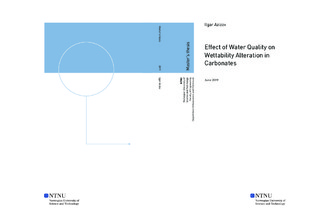| dc.description.abstract | The topic of the master's thesis is the wettability alteration in carbonates by Low Salinity enhanced oil recovery (EOR). Wettability alteration towards more water-wet upon reduction of salinity and/or manipulation of ionic composition of brine and consequent additional oil recovery is known as Low Salinity EOR. This master's thesis is the continuation of work done as part of a preliminary study during the master's specialization project. One of the goals of the thesis is to perform wettability alteration study on outcrop carbonate from the Ainsa Basin in the Spanish Pyrenees, which is selected to represent carbonate reservoir rock from a field in Brazil, operated by Equinor. Another goal is to build an experimental base for a wettability alteration study at elevated temperatures on reservoir core samples from the aforementioned field.
The wettability alteration in Ainsa carbonate was studied using the spontaneous imbibition (SI) tests at 96°C. Two sets of experiments, with two core plugs in each for reproducibility of results, were performed. The first set scrutinized influence of salinity reduction on wettability alteration using synthetic formation water (SFW), synthetic seawater (SSW) and ten times diluted SSW (10dSSW) as imbibing brines. While the second set investigated the effect of ionic composition using SSW, SSW with a doubled concentration of sulfate (SSW2SO4) and SSW with a fourfold concentration of sulfate (SSW4SO4).
The SI tests were supported by mineralogy, zeta potential and interfacial tension (IFT) studies. Based on mineralogy study by means of X-Ray Diffraction (XRD) and Energy-dispersive X-ray spectroscopy (EDS), Ainsa carbonate was classified as anhydrite free limestone mainly comprising calcite and quartz. Small amounts of K-feldspar, fluorite, and apatite were found as well. Zeta potential measurements showed that outcrop limestone material is reactive with potential determining ions (PDIs).
The result of SI tests showed that SSW is the most effective EOR fluid for crude oil-brine-rock system used in the experiment. Incremental oil recovery under SSW made up 10-18% of original oil in place (OOIP). When the core plugs were exposed to 10dSSW, after imbibition with SSW, no additional oil recovery was obtained. Imbibition under SSW2SO4 and SSW4SO4 resulted in low additional oil recoveries. SSW2SO4 recovered extra 1.5-3% of OOIP when used as imbibing brine after SSW. SSW4SO4 test on one core plug only extracted an additional 3% after SSW2SO4.
The new experimental setup was build for the SI tests at elevated temperatures on Ainsa carbonate core plugs. This setup allows the change of imbibing brine in the imbibition cell without interruption of the SI test. Overall, the setup performed as expected during the long term SI test and brine replacement. However, a few drawbacks were identified: the valves used for the setup tend to get clogged because of salt precipitation; although the brines were degassed, air bubbles were observed on the surfaces of the core plugs. | |
